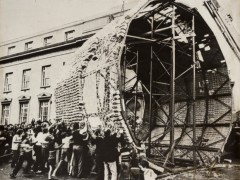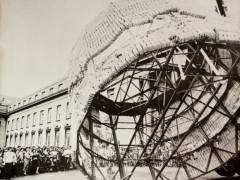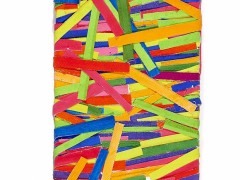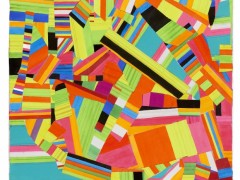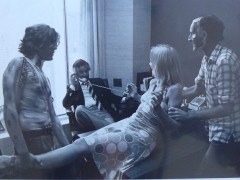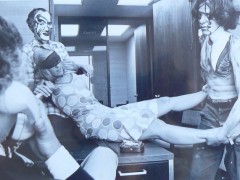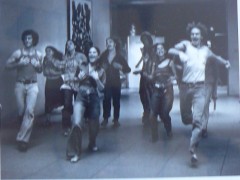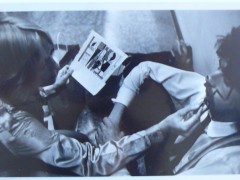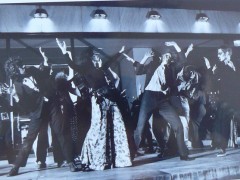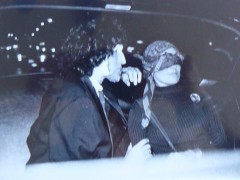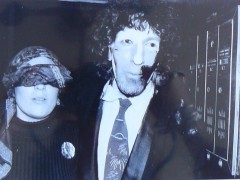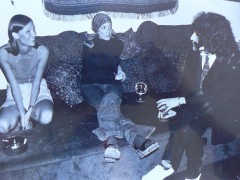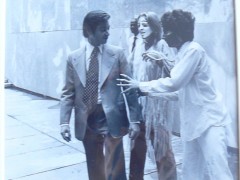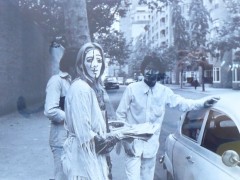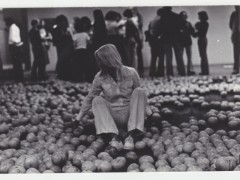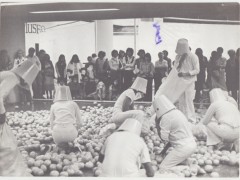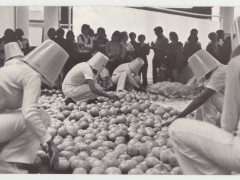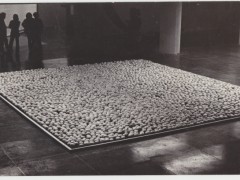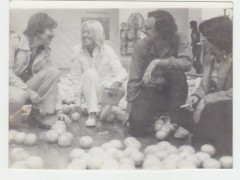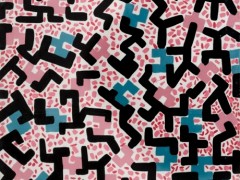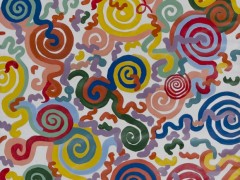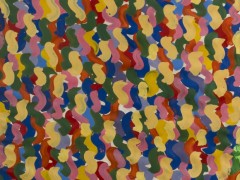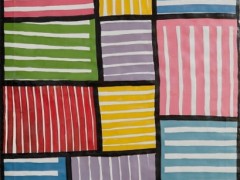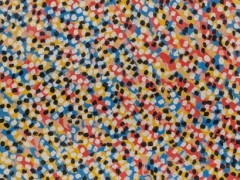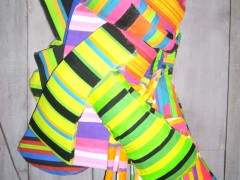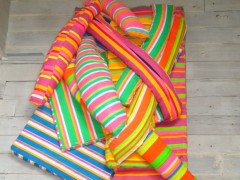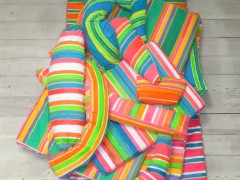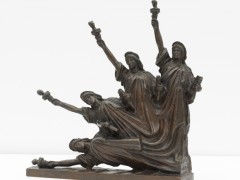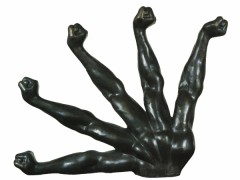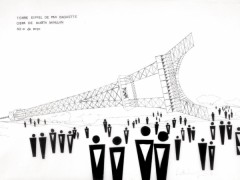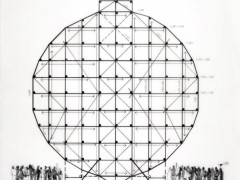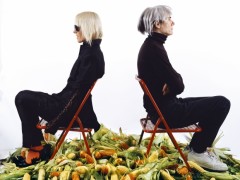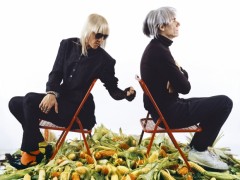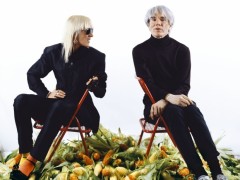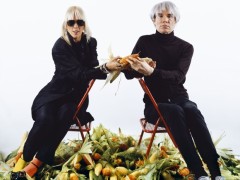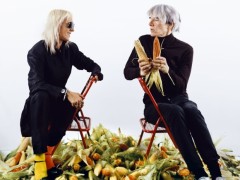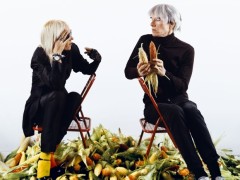Marta Minujín – Rebel Spirit
28.05 – 02.07 /2015
Henrique Faria Fine Art, New York.
Like kaleidoscopic wormholes to another dimension, the panels (five of which are included in this exhibition) that formerly lined the befuddling halls of Laberinto Minujinda [Minujinda Labyrinth] (1985) offer glimpses into one of Marta Minujín’s last technologically inflected, mixed-media environments. These panels’ hypnotic patterns, psychedelic colors, and imposing size immediately convey a sense of the discombobulating phenomenological address typical of most of Minujín’s art. Like many neo-avant-garde artists, Minujín seeks to radically integrate art with life not just as a critique of art’s autonomy and the art institution’s elitism but also as a demystifying experience, targeting the new power structures and spectacle culture of the postwar period. Indeed, after witnessing the rapid proliferation of mass media technologies and their transformation of all aspects of Argentine life in the 1960s, Minujín became resolutely opposed to the passive contemplation characteristic of traditional art forms, such as painting, which seemed incapable of articulating or questioning this new reality.
A clear outgrowth of Minujín’s most celebrated environments of the 1960s, such as La Menesunda [Mayhem] (1965) and El Batacazo [The Long Shot] (1965), Laberinto Minujinda activated its visitors through its multi-sensorial “situations,” consisting, for instance, of a tunnel of televisions, a hall with wobbly floors, and a “tactile room” filled with oddly textured objects to be touched. Although seemingly benign and amusing, this circuit’s radical de-familiarization of everyday objects and technologies, such as TV, aimed to be an unnerving awakening to its visitors. Minujín hoped that the estrangement provoked by these outlandish experiences would oblige participants to adopt new critical attitudes towards ordinary objects and the media. At the same time, an environment like Laberinto Minujinda subverted the art institution by providing a space in which the practices, encouraged by the artwork itself, trumped the tacit behavioral codes of the Centro Cultural Recoleta for which Laberinto Minujinda was created.
This sort of institutional critique was also present in Minujín’s happenings of the 60s and 70s. In Kidnapenning (1973), for instance, Minujín, accompanied by a troupe of actors, interrupted a cocktail party within MoMA’s Sculpture Garden to sing and perform a dance based on the classical postures of Greek art and Pablo Picasso’s paintings. The performers then “kidnapped” some of these guests, who were relocated to various lofts and public spaces throughout the city. Minujín thus created a clear opposition between the space of the museum and the realm of everyday life that paralleled the dichotomy between the mediation of traditional art—represented by the re-interpreted symbolism of Greek and Cubist poses—and the lived immediacy of the happening’s extra-artistic actions, such as the kidnappings.
This irreverent destabilization of cultural authority eventually extended itself to the foundational myths of nations. Minujín’s most monumental sculptures of the 80s, such as El Partenón de libros [The Parthenon of Books] (1983), La Torre de pan de James Joyce [James Joyce Bread Tower] (1980), and El Obelisco de pan dulce [The Fruitcake Obelisk] (1979), were, in reality, anti-monuments, which appropriated the forms of celebrated national landmarks only to better strip them of their mystique by constructing them out of commonplace foods. Bordering on parody, these sculptures were subsequently destroyed by throngs of people, who literally consumed these monuments’ edible building blocks—a metaphor for the mass subject’s assimilation of state propaganda (usually under the guise of “culture”) as constitutive of national identity. Created during Argentina’s military dictatorship as well as in its wake, many of these anti-monuments’ ephemerality presented a daring critique of the image of the state as a permanent and incontestable entity.
Minujín’s more modestly scaled bronze sculptures of the same period similarly “re-present” iconic chefs-d’oeuvres, usually emblematic of particular places. Expertly rendered to match the likeness of the Statue of Liberty, the Winged Victory, or the Venus de Milo, Minujín’s bronzes nevertheless disrupt the aura of these original, classical works by repeating or fragmenting the human figure. Reminiscent of Futurism’s dynamic lines and “vibrating” forms, the repeated figures give the impression of movement, of a rise and fall along the curve of a semicircle, like the hand of a clock, while the fragmented figures suggest a sort of temporal disjunction. In both cases, the canonical masterpiece’s ability to transcend the hic et nunc is put into question through this intimation of real time and space. Moreover, the series’ particular focus on ancient and classical art, which was habitually revived by the cultural production of fascist regimes, seeking the legitimizing caché of past civilizations, can be read as yet another veiled commentary on Argentina’s traumatic totalitarian experience.
El pago de la deuda externa argentina a Andy Warhol con maíz, “el oro latinoamericano” [Payment of the Argentine Foreign Debt to Andy Warhol with Corn, “The Latin American Gold”] (1985), one of Minujín’s most well-known performances of this same period, openly addressed Argentina’s political and economic situation. In this piece, Minujín symbolically paid Argentina’s foreign debt by giving Andy Warhol bushels of corn. Central to pre-Columbian cultures and associated with the natural wealth of the Americas since colonial times, the corn given by Minujín subtly linked Argentina’s financial difficulties of the eighties to a long history of colonization in which it, like other Latin American countries, had always figured as a mere source of raw materials to be harnessed by foreign powers. The choice of Warhol, an American artist, as the receiver of this payment further underscored the role of the United States as a neo-colonial power in the postwar period. At the same time, Minujín’s payment to the Father of American Pop poked fun at her critics, such as Marta Traba, who denigrated Minujín’s Pop-influenced art as a form of North American cultural imperialism. The dadaesque absurdity of the performance’s central gesture highlighted the risible reductiveness of her critics’ views on cross-cultural exchange, while recasting Minujín not as Warhol’s indebted vassal but as his equal—a position made visible through the two artists’ matching outfits and mirrored postures in photographs of the performance.
Despite the critical approach to much of Minujín’s oeuvre, many of her projects communicated a joie de vivre and vitality. Beginning in Paris in 1963, the ongoing “colchones” or mattress series consists of soft sculptures, whose intertwined parts and suggestive titles immediately evoke erotic activity. In fact, Minujín’s first inhabitable sculptures for this series, mainly La Chambre d’Amour [The Love Room](1963-64) and Revuélquese y viva! [Wallow Around and Live!] (1964), functioned as ludic spaces conducive to lovemaking—an activity already associated with the material of the mattress itself. Painted in fluorescent stripes, appropriated from the packaging of consumer products, these sculptures represent Minujín’s Pop aesthetic at its best.
Michaela de Lacaze
This post is also available in: Spanish

 Home
Home
